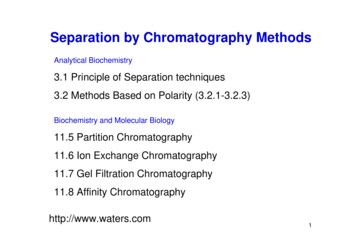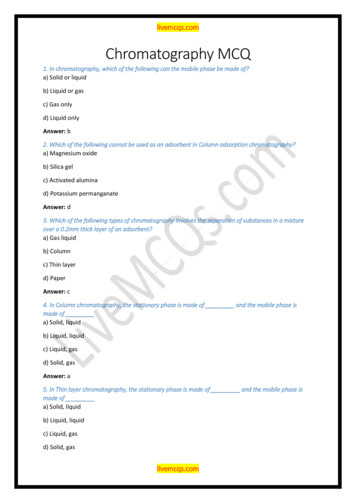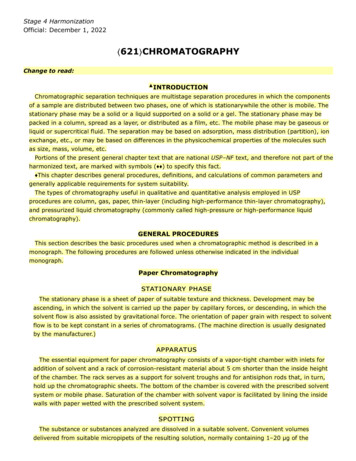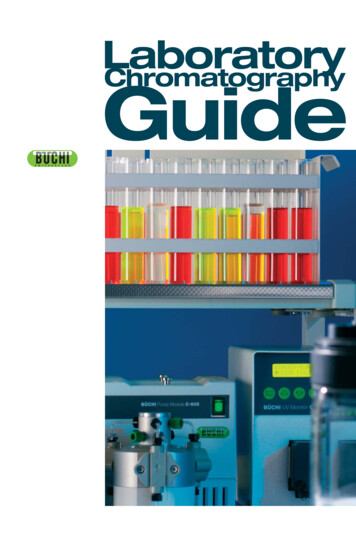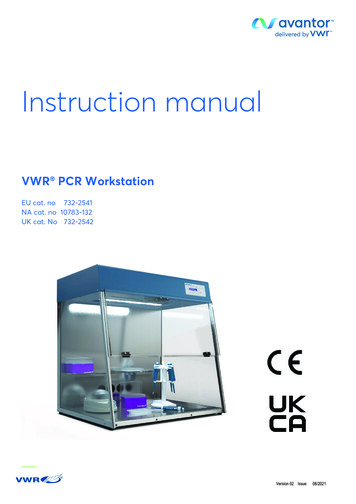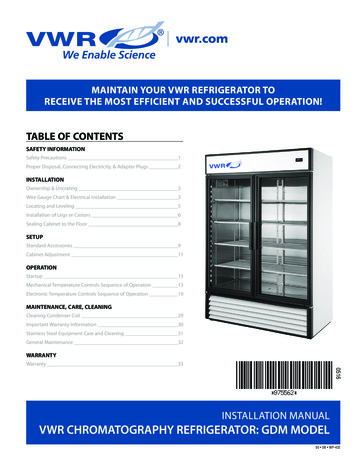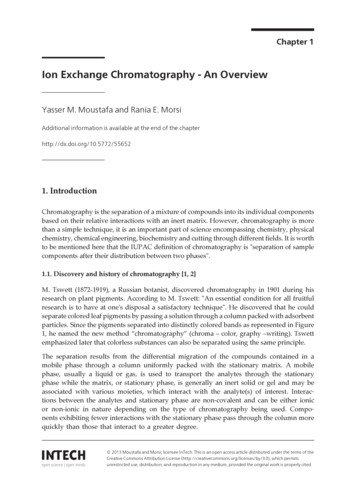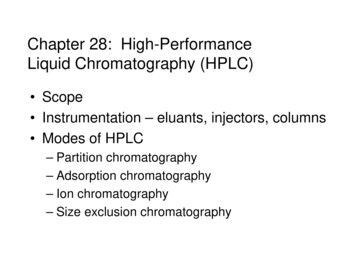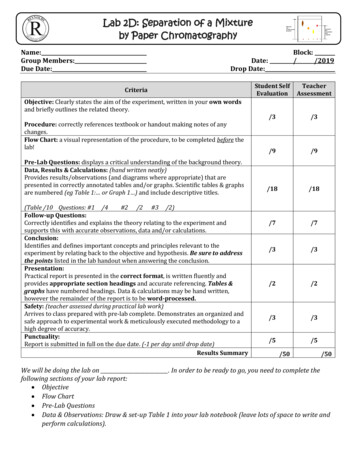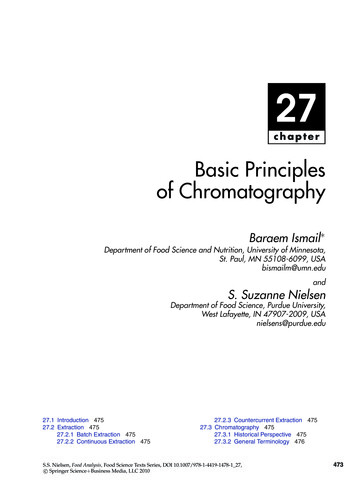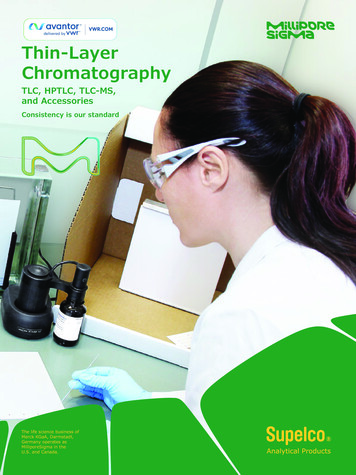
Transcription
Thin-LayerChromatographyTLC, HPTLC, TLC-MS,and AccessoriesConsistency is our standardThe life science business ofMerck KGaA, Darmstadt, Germany operates as MilliporeSigma in theU.S. and Canada.
ContentKey ApplicationsSucralose in Food4Lactose in Milk with HPTLC-MS5UV Filter in Sun Cream using HPTLC-MS6Identification Test for Atenolol and Chlorthalidone in Tablets followingEuropean Pharmacopeia Monograph on Silica Gel 60 G F254 Plates7Piperine in Black Pepper8Bitter Acids in Hops9General InformationBacking / Support10Format/ Plate Dimension11Multiformat Plates11Adsorbents / Layers12Layer Thickness12Binder12Indicators12TLC and HPTLC plates with Concentrating Zone13GLP Plates13Ordering InformationClassical Silica Plates for TLC14TLC Silica 60 G Plates with Gypsum16Modified Silica TLC Plates for Enhanced Selectivity17Aluminum Oxide TLC Plates18Kieselguhr and Mixed Layer Plates18Cellulose TLC and HPTLC Plates19High Performance Silica Plates (HPTLC)20ProteoChrom HPTLC Plates22Modified Silica HPTLC Plates23LiChrospher HPTLC Plates24TLC and HPTLC MS-grade Plates25PLC Plates for Separations from Milligrams to Grams27Multiformat Plates27TLC Adsorbents28Accessories29 2
Thin-Layer Chromatography (TLC)Thin-layer chromatography (TLC) is a fast, easy-to-use,and highly versatile separation technique forqualitative and quantitative analysis, it is ideal for rapididentification of ingredients, screening and reactionmonitoring. Its high matrix tolerance and the possibilityto separate many samples in parallel makes TLC highlycost-efficient. In addition, multiple detection methodsincluding visualization (derivatizations) and hyphenationto Mass Spectrometry (MS) enables a safe and preciseidentification of known and unknown compounds.Some benefits of TLC: Disposable plates ensure simplifiedsample preparation Direct visualization of results by UV or derivatization Analysis of many samples under identicalconditions simultaneously Easy two-dimensional separations Suitable for many applications, such as screening,rapid identity tests in drug synthesis, monitoringand easy upscaling for flash and preparativechromatography, and for quantitative analysis. Couple to MS or bioassaysTypical application fields for TLC include organicsynthesis as well as fast identity testing in qualitycontrol.In addition, TLC is an efficient tool for: Rapid analysis of ingredients in matrix-rich samples(e.g. QC in food or cosmetics) Fast screening of very complex samples (e.g. herbsor nutrition such as phytopharmaceuticalsor forensics) A complementary method to verify correct results(e.g. cross-checking HPLC-results in pharmaceuticaldrug development or cosmetics) Rapid and high throughput pre-screening priorto HPLCFurthermore TLC/HPTLC is well suited for: Full quantification of results usinginstrumental TLC/HPTLC Sample preparation for HPLC and otheranalytical methods Combination with mass spectrometry 2-dimensional chromatography Selective identification of compounds includingbiological activitiesWith our extensive history, experience, and know-how, we are the market leader in highest quality,reliable TLC & HPTLC plates and accessories. This gives you the peace of mind with regards to plateperformance and reproducibility, enabling you to focus solely on your separation challenges.Visit vwr.com/MilliporeSigma for further information.3
Key ApplicationsSimple and QuickSucralose in FoodIn food analysis we are often interested in only one or a fewtarget compounds. But these compounds are present in manydifferent samples, requiring different pre-treatments for quantitativeanalysis. TLC is an ideal method for rapid quantification of one orfew target compounds from complex and matrix-rich samples ofdifferent nature. The target compound needs only to be clearlyseparated from all matrix of the sample to be quantified using astandard compound.For the quantification of sucralose from different food samples,HPTLC was used without post-chromatographic derivatization. Fortysix chromatographic runs were performed in 40 minutes, thus theseparation time per sample is less than 1 minute per sample.DetectionChromatographyApplication dataOrdering informationPlateHPTLC Silica gel 60 NH2 F254 (20x10 cm)DescriptionSample preparationThe cake and biscuit sampleswere extracted with 70% aqueousmethanol.HPTLC Silica gel 60 NH2 F254 MS-grade, 20x10 cmEM1.13192.0001Acetonitrile - gradient grade for liquidchromatography LiChrosolv Reag. Ph EurEM1.00030.2500Sample applicationATS 4 sample applicator (Camag),6 mm bandwidthApplication volume2-4 µLMobile phaseAcetonitrile / Water 17:3 (v/v)Migration distance5 cmMigration time1.8 min / 2.8 minDocumentation equipmentDigiStore2 (Camag)Wavelengthscan under UV-light at 366/ 400nm with TLC scanner 3 (Camag)StainingnoneCat. No.Water for chromatography (LC-MS Grade) LiChrosolv EM1.15333.2500G. Morlock, M. Vega, J. Planar Chromatogr. 20 (2007) 411-4174Thin-Layer Chromatography
Fast and sensitiveLactose in Milk with HPTLC-MSFood intolerances are of increasing importance. In particular, lactoseintolerance has recently gained a lot of attention not only in Asiancountries, but also in Europe and North America.Foodstuff with a lactose content of less than 100 mg/100 g could belabeled as “lactose-free”. Traditionally, analysis is carried out usingphotometric measurements in single cuvettes, or in 96-well plates by usingan enzymatic test kit.HPTLC coupled to MS enables much simpler and faster identification andquantification. Lactose in different samples like milk, yoghurt and an instantsauce can be analyzed in parallel without complex sample preparation.Application dataPlateDetectionExtractionChromatographySample preparationOrdering informationHPTLC Silica gel 60 F254 MS-grade,20x10 cmMilk: 2 x 5 min centrifuged, then 1mLdiluted in 50 mL waterYoghurt: 1 g diluted in 10 mL water,afterwards 1 x centrifuged rpm 6000Instant sauce: sauce cooked as directed,1 g sauce diluted in 10 mL water,afterwards 1 x 5 min centrifugedSample applicationATS 4 sample applicator (Camag), 6 mmbandwidthApplication volume0.1 - 4 µLMobile phaseAcetonitrile / Water 3/1 (v/v) 0.1%Trifluoroacetic acidMigration distance5 cmMigration time12 minExtraction equipment“TLC-MS Interface” from CamagExtraction solventAcetonitrile / Water 95/5 (v/v) 0.1%Formic acidExtraction flow0.2 mL/minDocumentationequipmentTLC Visualizer (Camag)Wavelengthscan at white lightStainingAniline-diphenylamine-phosphoric acidreagent heated 10 min at 120 CMS equipmentsingle-quadrupole mass spectrometerexpression CMS (Advion)MS detectionESI ( ) mode (m/z 50 - 1200)DescriptionCat. No.HPTLC Silica gel 60 F254 MS-grade, 20x10 cm10755-322Acetonitrile hypergrade for LC-MS LiChrosolv EM1.00029.2500Trifluoroacetic acid for spectroscopy Uvasol EM1.08262.0100Diphenylamine for synthesisEM8.20528.0100Aniline for analysis EMSURE EM1.01261.1000Ortho-Phosphoric acid for analysis EMSURE EM1.00573.1000Chromatogram (derivatized with Aniline-di-phenylamine-phosphoricacid reagent) under white light.Determinded Lactose valuesOrganic fresh milk4.68 g/100 gUHT milk4.36 g/100 gLactose free UHT milk 100 mg/100 gInstant sauce1.64 g/100 gYoghurt5.49 g/100 gc/s 182,217E616E615E6In-source fragm14E613E612E611E6[M Na] 10E6365,29E68E6406,1 [M Na ACN] 7E66E65E64E63E62E61E60E61.000500LactoseM 342.3 g/molMass spectrum oflactose-zone fromyoghurt sample, eluteddirectly from the TLCplatem/z5
Robust and AccurateUV Filter in Sun Cream using HPTLC-MSAnalytical verification of cosmetic products can be a challenging task.Formulations like creams, balms or lotions are complex matrices withrespect to chromatography, so quick and simple sample preparation anda direct analysis method is appreciated. Thin-layer chromatography-massspectrometry (TLC-MS) is such an analytical technique which allows theanalysis of these complex samples with minimum sample cation DataPlateHPTLC RP-18 F254S MS-grade, 20x10 cmSamplepreparation1 g Sun Cream stirred in 10 mL 2-propanol, filtration14Application volume 0.5 - 5 µl567Sun Cream 1Mobile phaseMethanol / Acetonitrile 9/1 (v/v)Migration distance5 cmMigration time11 min8910Extractionequipment"TLC-MS Interface" from CAMAGExtraction solventAcetonitrile / Water 95/5 (v/v) 0.1% Formic acidExtraction flow0.2 mL/minDocumentationequipmentDocumentation unit Reprostar / Digistore (CAMAG)WavelengthScan under UV-light at 254 nm and 366 nmStainingNoneMS equipmentACQUITY Qda Detector, Single-Quadrupole MassSpectrometerMS detectionESI ( /-) mode MS (m/z 50-350)Fig. 2: Developed plate at 254 nmChromatographic dateTrack Compound Concentration Application hRf ndard0.12, 3, 4, 550 311.2Cat. No.5-7SunCream#10.10.550 311.28-10SunCream#20.10.550 311.210755-328HPTLC RP-18 F254S MS-grade, 20x10 cmEM1.00029.2500Acetonitrile hypergrade for LC-MS LiChrosolv 2-Propanol gradient grade for liquid chromatography LiChrosolv EM1.01040.1000 EM1.06035.1000Methanol for LC-MS LiChrosolv EM1.00264.1000Formic acid for analysis EMSURE Water for chromatography (LC-MS Grade) LiChrosolv 1.5x107EM1.15333.10000.296 ExtractedEusolex 9020M 310.4 g/mol1.0x1075.0x1060.0Sun Cream 2Eusolex 9020 standardDescription[M H] 311.2333.3[M Na] 210.00 220.00 230.00 240.00 250.00 260.00 270.00 280.00 290.00 300.00 310.00 320.00 330.00 340.00 350.00 360.00 370.00 380.00 390.00 400.00m/zFig. 1: Mass spectrum and structure of Eusolex 9020, recorded at hRf value of 50 at track 5.63Sample application ATS 4 sample applicator (CAMAG) 6 mm bandwidthOrdering informationIntensity2Thin-Layer Chromatography
Meet Regulations in PharmaIdentification Test forAtenolol and Chlorthalidonein Tablets following EuropeanPharmacopeia MonographAtenolol is a selective β1 receptor antagonist, belongingto the group of beta blockers, a class of drugs usedprimarily in cardiovascular diseases.Chlorthalidone is a diuretic drug used to treathypertension, originally marketed as Hygroton in theUSA. It is described as a thiazide diuretic, and oftenused in the management of hypertension and edema.With this application note we illustrate how silicagel G F254 plates are suitable for analysis of Atenololand Chlorthalidone in a combination drug followingthe experimental conditions per the EuropeanPharmacopeia identification TLC test for Atenolol(version 9.0).Ordering informationCat. No.DescriptionTLC Silica gel 60 G F254 20 x 20 mm, glass plate, Pk.251-Butanol for liquid chromatography LiChrosolv EM1.01988.1000Ammonia solution 25% SuprapurEM1.05428.0250 AtenololChlorthalidoneExperimental ConditionSilica Gel 60 G F254, 20 x 20 cmTLC PlateApplication volume 5 µL of each solutionDetectionUV @ 254 nmMobile phase18 M Ammonia and n-butanol 30:150 (v/v)52428-716Methanol gradient grade for liquid chromatography EM1.06007.1000LiChrosolv Reag. Ph Eur.Atenolol European Pharmacopoeia (EP)Reference StandardAtenolol Pharmaceutical Secondary Standard;Certified Reference MaterialChlorthalidone European Pharmacopoeia (EP)Reference StandardPlate development Line the walls of chromatographic tank withfilter paper. Pour a sufficient quantity of mobilephase into the chromatographic tank. Saturatethe chromatographic tank, replace the lid andallow to stand at 20-25 C for 1 hr. Apply theprescribed volume of the solutions in sufficientlysmall portions to obtain bands at an appropriatedistance from the lower edge.Migration distance 15 cmDryingin airStandard1.0 % (w/v) of atenolol in 0.25 % (w/v) ofChlorthalidone in methanolSampleRemove any film coating on the tablet powder andshake the quantity of powered tablet containing0.1 g of atenolol with 10 mL of methanol for15 minutes and filter.TLC Plate Development7
Regulated Method: Food & BeveragePiperine in Black PepperPiperine is the spice and active component of black pepper, is able to influencedrug metabolism.With a regulated method, one must follow the monograph instead of justputting the sample at the center of the decision making, so it is purelyfollowing the instructions in the monograph. In this application, we havechosen powdered black pepper as an example, and have tested it accordingto the United States Pharmacopeia (USP) guidelines (USP40-NF35).DetectionChromatographyApplication dataPlateHPTLC Silica gel 60 F254(20x10 cm)SamplepreparationSonicate for 10 minabout 0.5 g of powderedblack pepper in 5 mL ofmethanol, centrifuge anduse the supernatantSampleapplicationATS 4 sample applicator(Camag), 8 mm bandwidthMobilephasen-Hexane / Ethylacetate5:3Migrationdistance5 cmWavelengthscan under visible light,UV-light at 254 nm and366 with TLC scanner 3(Camag)Staining /DerivatizationA mixture of 17 mL ofice-cooled methanol,2 mL of acetic acid,1 mL of sulfuric acid and0.1 mL of anisaldehydeFeatured ProductsDescriptionCat. No.TLC & HPLCEM1.05642.0001HPLC glass plates Si 60 F254, 20 x 10 cmPurospher STAR RP-18 endcapped (5 µm) Hibar RT 250-4.6 EM1.51456.0001Solvents & reagentsEthyl acetate for liquid chromatography LiChrosolv 1.00868.1000EM1.04391.1000n-Hexane for liquid chromatography LiChrosolv Water for chromatography (LC-MS Grade) LiChrosolvEM1.15333.1000Acetonitrile - gradient grade for liquid chromatographyLiChrosolv , Reag. Ph EurEM1.00030.2500Methanol - gradient grade for liquid chromatographyLiChrosolv , Reag. Ph EurEM1.06007.1000 Track 1: 3 μL standard solution A, USP reference standard (RS) of0.9 mg/mL piperine in methanol. Track 2: 3 μL standard solution B, a 2 mg/mL borneol standardin methanol. Track 4 & 5: 7 μL two different commercial pepper samples of thesame concentration taken through the same sample preparation steps.(add about 0.5 g of powdered black pepper to 5 mL of methanol,sonicate for 10 minutes, and then use the supernatant). Track 3: 15 μL standard solution C, USP powdered black pepperextract RS 5 mg/mL in methanol, sonicated, centrifuged, and thesupernatant is used.Application Results1. Under 254 nm, the chromatogram of the sample solution exhibitsan intense quenching band at Rf of about 0.15 corresponding to thepiperine band in the chromatogram of standard solution A2. A quenching band at Rf of about 0.023. Three quenching bands of similar intensity equally spaced locatedbetween4. Under white light, the derivatized chromatogram of the samplesolution exhibits main bands similar in position and color to the main8Thin-Layer Chromatographybands in the chromatogram of Standard solution C5. These bands include a dark green band of the same color and Rf asthe piperine band in Standard solution A (RF of about 0.15)6. A weak violet band at Rf of about 0.47 below the position of the banddue to borneol in Standard solution B7. A greenish band in the lower part of the chromatogram at Rf ofabout 0.07
From Plant Screening to QuantificationBitter Acids in HopsThe amount of bitter acids in hops is a very important parameter for beerproduction. Different types of hops contain different quantities of α- andß-acids which are responsible for the bitterness of the beer. In general,hops are divided into aromatic hops ( 10% α-acids) and bitter hops( 10% α-acids).In this study, a total of 12 samples were analyzed: four aromatic hops,four bitter hops and four hops of the same variety, but from differentregions. The sample extracts were applied on HPTLC silica gel 60 F254MS-grade plates, and developed and separated with a gradient using theAutomated Multiple Development (AMD 2) System. Fluorescence wasmeasured at 360/ 400 nm.Application DataOrdering informationPlateHPTLC RP-18 F254s MS-grade, 20x10 cmDescriptionStandard1 mg/mL of the International Calibration Extract 3 (contains 44.64%alpha acid, 24.28% beta acid and 31.08% other ingredients)HPTLC silica gel 60 F254 MS-grade, 20x10 cmSamplepreparationCrumbled the hop-pellets (5 g), added 10.0 mL MeOH, 50.0 mLdiethyl ether and 20 mL 0.1 molar hydrochloric acid solution.The solution stirred for 40 min, 2 mL of the upper ether phaseremoved, the residue filled in a 20.0 mL volumetric flask and filledup with MeOH. The extract filtered with a 0.45 μm syringe filter.Sample application ATS 4 automatic TLC sampler (Camag), 6 mm bandwiseEM1.04390.1000chromatography LiChrosolv Ethyl acetate for liquidEM1.00868.1000chromatography LiChrosolv Methanol for liquidApplication volume 0.3 – 1.6 μLMobile phasen-Heptane for liquidCat.No.10755-322EM1.06018.1000chromatography LiChrosolv Ethyl acetate/Methanol/n-Heptane as a gradient, developedwith the AMD 2 automated multiple development (Camag)Steps EthylacetateMethanol150.0 Vol%50.0 Vol% 00 Vol%12.0 mm2.0 min240.0 Vol%40.0 Vol% 20 Vol%18.0 mm2.0 minDiethyl ether for spectroscopy Uvasol EM1.00930.1000n-Heptane Migration DryingDistance TimeNo. Hops.Content [%] ofα-acidsß-acidsAromatic Hops335.0 Vol%35.0 Vol% 30 Vol%24.0 mm2.0 min430.0 Vol%30.0 Vol% 40 Vol%30.0 mm2.0 min1Mittelfrüh Hallertau2.73.0525.0 Vol%25.0 Vol% 50 Vol%36.0 mm2.0 min2Spalt 16.0620.0 Vol%20.0 Vol% 60 Vol%42.0 mm2.0 min3715.0 Vol%15.0 Vol% 70 Vol%48.0 mm2.0 min4810.0 Vol%10.0 Vol% 80 Vol%54.0 mm2.0 min95.0 Vol%5.0 Vol%60.0 mm2.0 minBitter Hops5ApolloMigration distance 5 cm6Green BulletMigration time55 min (complete AMD method)7Hallertau HerkulesDocumentationequipmentReprostar 3 (Camag)8TopazWavelengthUV-light at 366 nmScan equipmentTLC scanner 3 (Camag)WavelengthUV-light at 360 nm90 Vol%4.03.316.27.2Regional Hops9Cascade NZ4.03.910Cascade USA8.18.011Cascade Hallertau D6.56.112Cascade Lemondrop USA4.14.29
TLC Plates to Fit Your NeedsAs the leading supplier of thin-layer chromatography consumables, we offer anportfolio of plates, reagents and accessories for TLC, preparative TLC, and highTLC (HPTLC). In addition, we also offer special MS-grade TLC and HPTLC platesperfect combination with mass spectrometry. Each of our high quality productsstandards in quality, performance and utility.extensiveperformancefor theis setting newPick your plateGlass, aluminum or plastic? You have the choice with our classical silica TLC plates. Each isavailable in a broad range of sizes from 20 x 20 cm down to 2.5 x 7.5 cm. They offer a layerthickness of 250 μm for glass plates and 200 μm for aluminum or plastic, with a mean particlesize of 10 - 12 μm. Special plates with a thinner or thicker layer are available, ideal for TLC-MSfor example.Plate Backing or SupportClassical silica TLC plates are available with glass, aluminum or plastic backings.The flexible aluminum or plastic sheets can be easily cut with scissors to suit individualseparation sGlassRigidFragileTransparentCannot be easily cut into desired sizeEconomical (reusable)Heavy – high transport costsHigh chemical resistanceThick ( 1.0 mm) – about 5x more shelf space thanaluminum or plastic-backed platesMost commonly used supportAluminum FoilGood heat stability for charringBacking highly susceptible to breakage(potential safety issue)Easy to handle/safe – resistant to breakageBacking is not reusableCan be easily cut to desired dimensions with scissorsNot as chemically resistant as glass to reagents such asmineral acids and concentrated ammoniaThin ( 0.15 mm) – minimal storage spaceLightweight – lower shipping costsSolvent resistanceStrong adsorbent layer adherence – good for use witheluents containing high concentrations of waterGood heat stabilityCan be stored in lab notebookPlastic (Polyester – PET)Easy to handle/safe – resistant to breakageBacking is not reusableCan be easily cut to desired dimensions with scissorsLower heat stability – charring must be done at lowertemperatures than with glassThin ( 0.2 mm) – minimal storage spaceLightweight – lower shipping costsSolvent resistanceCan be stored in lab notebook10Thin-Layer ChromatographyFlexible – adsorbent layer may be more susceptibleto cracking
Format and Plate DimensionsTLC and HPTLC plates are available in several different dimensions. The plates dimension (size)is given in cm (e.g., 20x20 cm). Here the first number indicates the plate width an the secondthe plate height. The migration direction is indicated below:20x20 cm10x20 cm20x10 cm10x10 cmGlass platesAluminum sheetsPlastic sheets20 2020 2020 2010 20 (TLC)5 20500 2020 10 (HPTLC)5 7.55 20500 205 102.5 7.5Multiformat PlatesMultiformat glass plates are pre-scored so that theycan be easily snapped by hand into smaller sizes.The plates utilize the same proven silica gel coatingas the corresponding non-scored TLC or HPTLC plate,delivering chromatograms of equally high quality.How to use Multiformat TLC and HPTLC PlatesThe number of possible plates depends on the scoring.For example, for a 20 20 cm plate scored in sectionsof 5 10, up to seven different formats are possible: 5 cm 10 cm 5 cm 20 cm 10 cm 10 cm 10 cm 15 cm 10 cm 20 cm 15 cm 20 cmNote: To prevent the glass backing from breaking in an uncontrolledand irregular manner, avoid putting plates directly on hot metal plates,drying cabinets or plate heaters after development and/or staining.When heat drying is necessary, please use distance holders of lowthermal conductivity between the glass and the hot metal plate, i.e.glass rods or similar. 20 cm 20 cmFeatures and Benefits Simply snap to desired size Same high quality as classical non-scored TLC andHPTLC plates Up to 7 formats in one plate1111
Adsorbent / LayersOur glass, aluminum foil and plastic PET (polyester) TLCand HPTLC plates are available coated with a varietyof adsorbents and are available with and withoutfluorescent indicator. Cellulose – available as either microcrystalline orfibrous cellulose. Spots are generally more compactwhen separated on layers of microcrystalline cellulosethan when separated on layers of fibrous cellulose. Silica gel (unmodified, modified/bonded, chiral andhigh purity) is the most common TLC sorbent. Kieselguhr is a natural diatomaceous earth that canbe used for the separation of polar or moderatelypolar compounds. Aluminum oxide which exhibits similar selectivity,although slightly different, to silica is the second mostcommon TLC sorbent.Layer ThicknessThe layer thickness of our glass TLC plates is250 μm, and 200 μm for aluminum or plastic, with amean particle size of 10–12 μm.For HPTLC, we use an optimized silica 60 sorbentwith a significantly smaller particle size: just 5–6 μmcompared to 10–12 μm used for classical TLC. Thisenables a higher packing density and hence a smoothersurface. Band diffusion is also reduced, producing verycompact sample bands or spots. These features and thethinner layer (200 μm or 100 μm) ultimately leads tohighly increased sensitivity and faster analysis.BinderPolymeric (organic) binder:Gypsum:Our unique binder technology ensures a uniform andhard surface of the TLC plate that will not crack or blister.Traditional silica plates contain a polymeric (organic)binder of high molecular weight acrylic acid polymersfor the most rugged plates, making sample handlingand application easier. They also permit the use ofhigher water content in the developing solvent. They aregenerally recommended for all TLC applications and inmany applications outstanding suitability with no negativeinfluence on the chromatographic result has been proven.Gypsum as a binder is recommended for TLC usersin QA/QC labs following older Ph. Eur. monographmethods, which require TLC plates with gypsum binder,and who do not wish to switch to classical TLC plateswith organic binders. Our TLC silica gel 60 G plates arebest suited for this approach.Binder in cellulose plates: The binder we use for ourcellulose plates is Carboxymethylcellulose.IndicatorsWe also provide two kinds of inorganic fluorescentindicators for UV detection of colorless substances: thegreen fluorescing F254 or the blue fluorescing, acid-stableF254s, both of which fluoresce in UV light at an excitationwavelength of 254 nm. Samples which absorb shortwaveUV at 254 nm are detected due to fluorescencequenching. For superior identification of separatedsubstances, our exceptional high-fluorescent LuxPlates contain a higher amount of fluorescent indicator.12Thin-Layer ChromatographyF254LuxPlate F254s
TLC and HPTLC Plates with Concentrating ZoneQuick and Easy Application of Large SampleVolumesOur concentrating zone plates are based on the differentproperties of two silica adsorbents: an inert, largepore concentrating adsorbent where the samples areapplied; and a selective separation layer. Independentof the shape, size or position of the spots, the samplealways concentrates within seconds as a narrow bandat the interface of the two adsorbents. In addition,the concentrating zone can serve as a clean-up stepfor analytes in complex matrices, such as oils andcosmetics. Suitable for TLC, HPTLC and PLC, theseApplicationConcentrationplates allow easy application of large volumes of dilutedsamples. The concentrating zone is 2.5 cm for ouranalytical TLC and HPTLC plates, and 4 cm in length forour PLC plates.Features and Benefits Quick and easy sample application Highly facilitated sample loading Better resolution due to focused bands Includes purification and concentration stepsSeparationGLP-PlatesWith Individual Laser Coding for SecureDocumentationBased on the proven silica gel 60, manufactured byMerck KGaA, Darmstadt germany, our GLP platesdeliver the same unsurpassed separation performanceas the corresponding TLC or HPTLC plates. The onlydifference is that each of our laser-coded GLP platesis marked with an item, batch, and individual platenumber. This allows you to easily record and archiveevery plate you use. Our GLP plates are available asTLC or HPTLC grade in various formats, with or withoutthe fluorescence indicator F254, which is stimulated togreen emission at 254 nm.Features and Benefits Convenient back tracing of article, batch, andindividual plate number Easy documentation and archiving of every plate Same reliable performance as TLC and HPTLC platesmanufactured by Merck KGaA, Darmstadt, Germany13
Ordering InformationClassical Silica Plates for TLCReliable routine analysis of a broad range of substancesUnmodified silica is the most widely used sorbent inTLC. There’s a good reason for this: when combinedwith a suitable mobile phase, it allows you to analyzealmost any substance. The smooth and extremely denseplate coating ensures narrow bands and maximumseparation efficiency with lowest background noise. Oursilica plates offer all these advantages and more. Theyutilize the well-established MilliporeSigma silica gel 60together with a unique polymeric binder, which resultsin a uniform, hard surface that will not crack or blister.Unmodified silica gel covers nearly 80% of bothadsorption and partition TLC applications. It enablesseparation of a large range of diverse substances,such as alkaloids, anabolics, carbohydrates, fattyacids, glycosides, lipids, mycotoxins, nucleotides,peptides, pesticides, steroids, sulfonamides, surfactants,tetracyclines and many others. This makes it suitable for: In-process control in drug synthesis Identity and stability testing of drugs Quality control of pharmaceuticals, food andenvironmental samples Residue analysis in food and environmental samples Highest quality Most reliable batch-to-batch consistency Unsurpassed robustnessTLC unmodified silica gel 60DescriptionLayer Sorbent/CoatingMaterialLayerThickness/ µm Format/cmSupport/BackingPack size/contentTLC Silica gel 60Silica gel 6025020 x 20glass25 platesEM1.05721.0001TLC Silica gel 60Silica gel 6025010 x 20glass50 platesEM1.05626.0001TLC Silica gel 60Silica gel 602505 x 20glass100 platesEM1.05724.0001TLC Silica gel 60Silica gel 602502.5 x 7.5glass100 platesEM1.15326.0001TLC Silica gel 60 F254Silica gel 60 F254*125020 x 20glass25 platesEM1.05715.0001TLC Silica gel 60 F254Silica gel 60 F254*125010 x 20glass50 platesEM1.05729.0001TLC Silica gel 60 F254Silica gel 60 F254*12505 x 20glass100 platesEM1.05714.0001TLC Silica gel 60 F254Silica gel 60 F254*12505 x 20glass25 platesEM1.05808.0001TLC Silica gel 60 F254Silica gel 60 F254*12505 x 10glass200 platesEM1.05719.0001TLC Silica gel 60 F254Silica gel 60 F254*12505 x 10glass25 platesEM1.05789.0001TLC Silica gel 60 F254Silica gel 60 F254*12502.5 x 7.5glass*3100 platesEM1.05794.0001TLC Silica gel 60 F254Silica gel 60 F254*12502.5 x 7.5glass*4100 platesEM1.15327.0001TLC Silica gel 60 F254Silica gel 60 F254*12502.5 x 7.5glass500 platesEM1.15341.0001LuxPlate silica gel 60 F254LuxPlate silica gel 60 F254*125020 x 20glass25 platesEM1.05805.0001LuxPlate silica gel 60 F254LuxPlate silica gel 60 F254*125010 x 20glass50 platesEM1.05804.0001LuxPlate silica gel 60 F254LuxPlate silica gel 60 F254*12505 x 10glass25 platesEM1.05802.0001LuxPlate silica gel 60 F254LuxPlate silica gel 60 F254*12502.5 x 7.5glass100 platesEM1.05801.0001TLC Silica gel 60Silica gel 6020020 x 20aluminum25 sheetsEM1.05553.0001TLC Silica gel 60Silica gel 602005 x 10aluminum50 sheetsEM1.16835.0001TLC Silica gel 60 WSilica gel 60 W*520020 x 20aluminum25 sheetsEM1.16487.0001TLC Silica gel 60254Silica gel 60 F254*120020 x 20aluminum25 sheetsEM1.05554.0001TLC Silica gel 60254Silica gel 60 F254*120010 x 20aluminum25 sheetsEM1.05570.0001TLC Silica gel 60254Silica gel 60 F254*12005 x 20aluminum100 sheetsEM1.05534.0001TLC Silica gel 60 F254Silica gel 60 F254*12005 x 10aluminum50 sheetsEM1.16834.0001TLC Silica gel 60 F254Silica gel 60 F254*12005 x 7.5aluminum20 sheetsEM1.05549.0001TLC Silica gel 60 F254Silica gel 60 F254*1200500 x 20aluminum1 rollEM1.05562.0001TLC Silica gel 60Silica gel 6020020 x 20plastic25 sheetsEM1.05748.0001TLC Silica gel 60 F254Silica gel 60 F254*120020 x 20plastic25 sheetsEM1.05735.0001TLC Silica gel 60 F254Silica gel 60 F254*12004x8plastic50 sheetsEM1.05750.0001TLC Silica gel 60 F254Silica gel 60 F254*1200500 x 20plastic1 rollEM1.05749.0001 F254 Fluorescent indicator*114 F254s Fluorescent indicator, acid stable*2Thin-Layer Chromatographypaper box*3plastic box*4W: water-resi
MS equipment ACQUITY Qda Detector, Single-Quadrupole Mass : Spectrometer MS detection : ESI ( /-) mode MS (m/z 50-350) Ordering information : Description Cat. No. HPTLC RP-18 F: 254: S MS-grade, 20x10 cm 10755-328: Acetonitrile hypergrade for LC-MS LiChrosolv .
